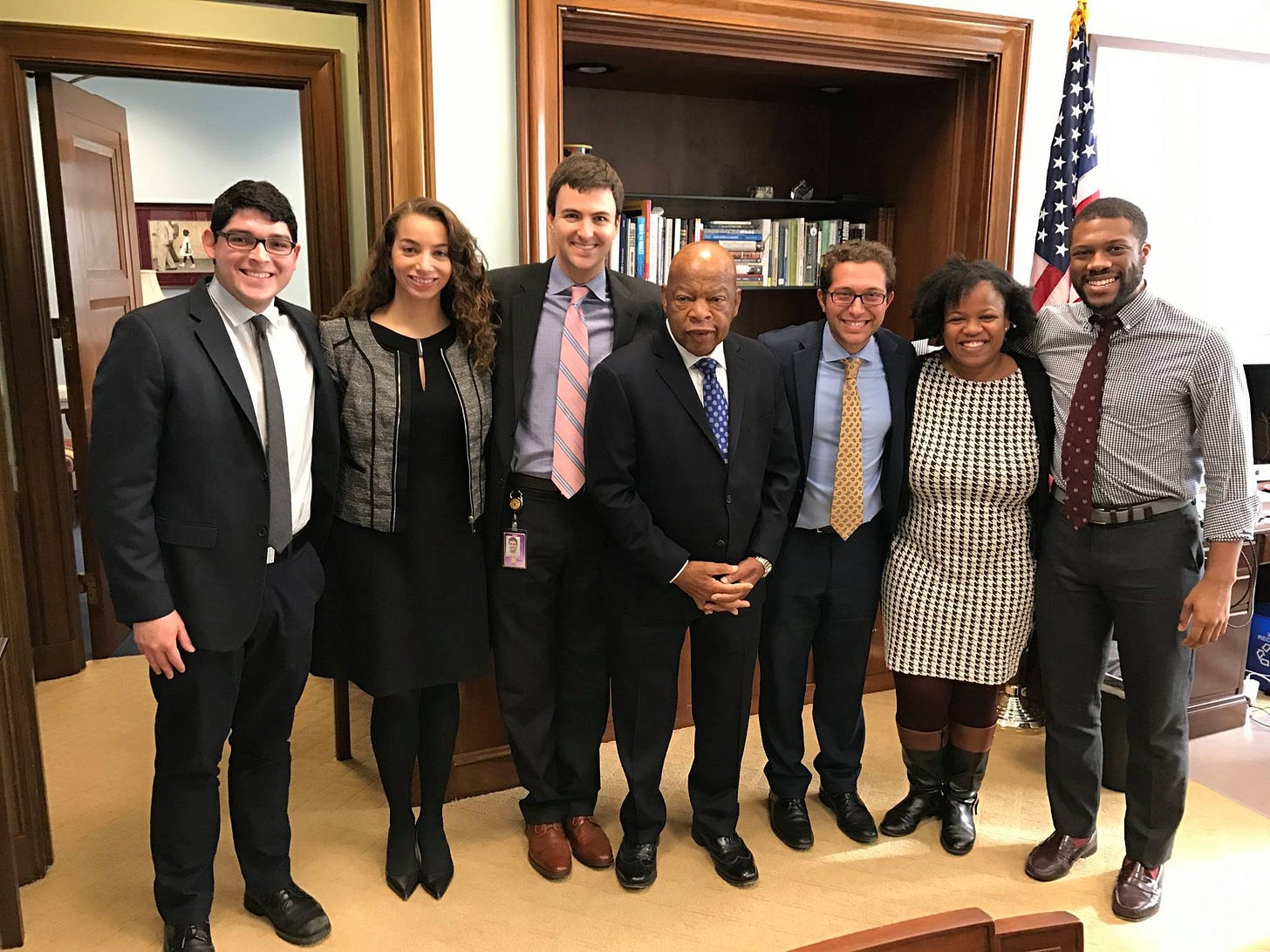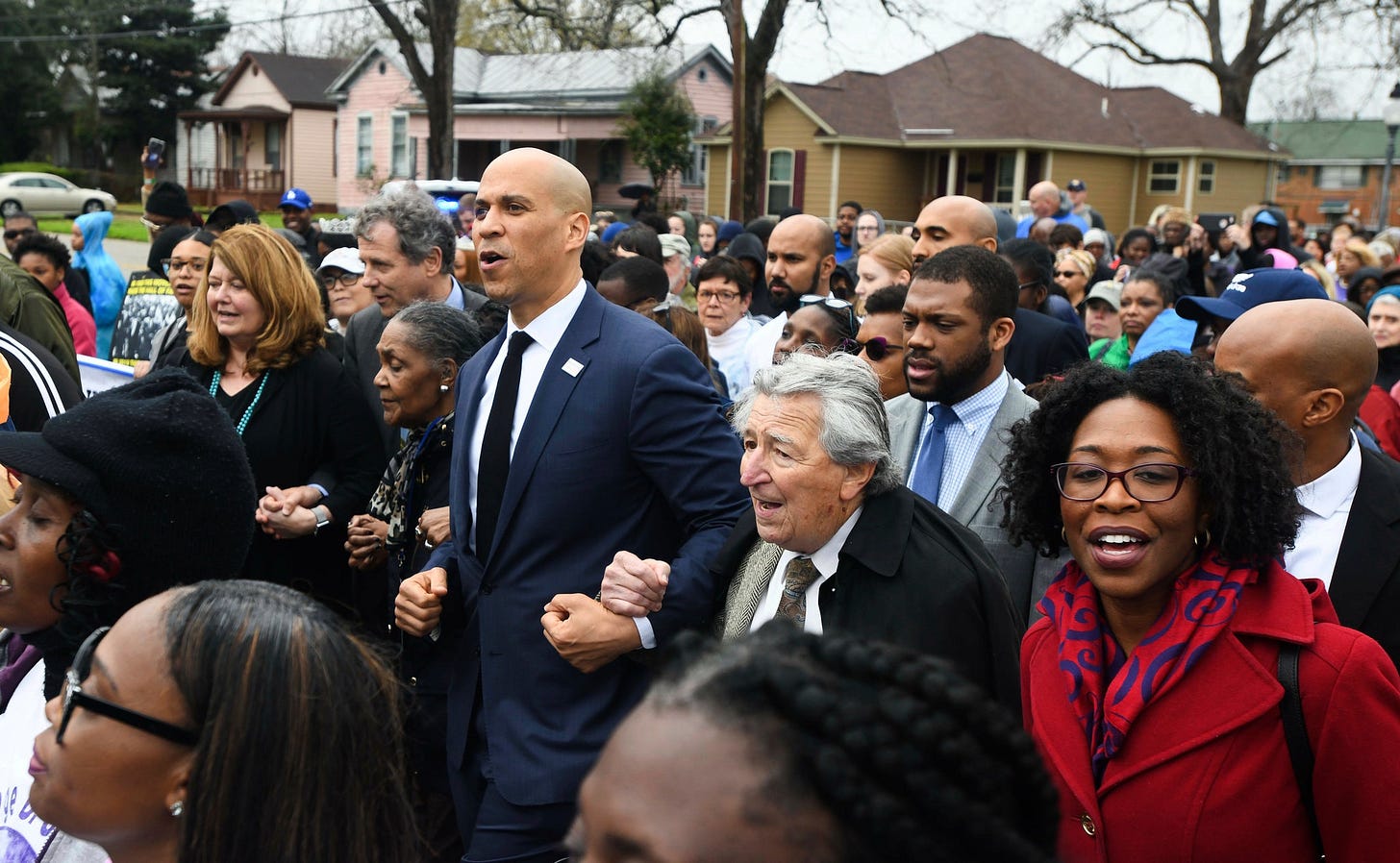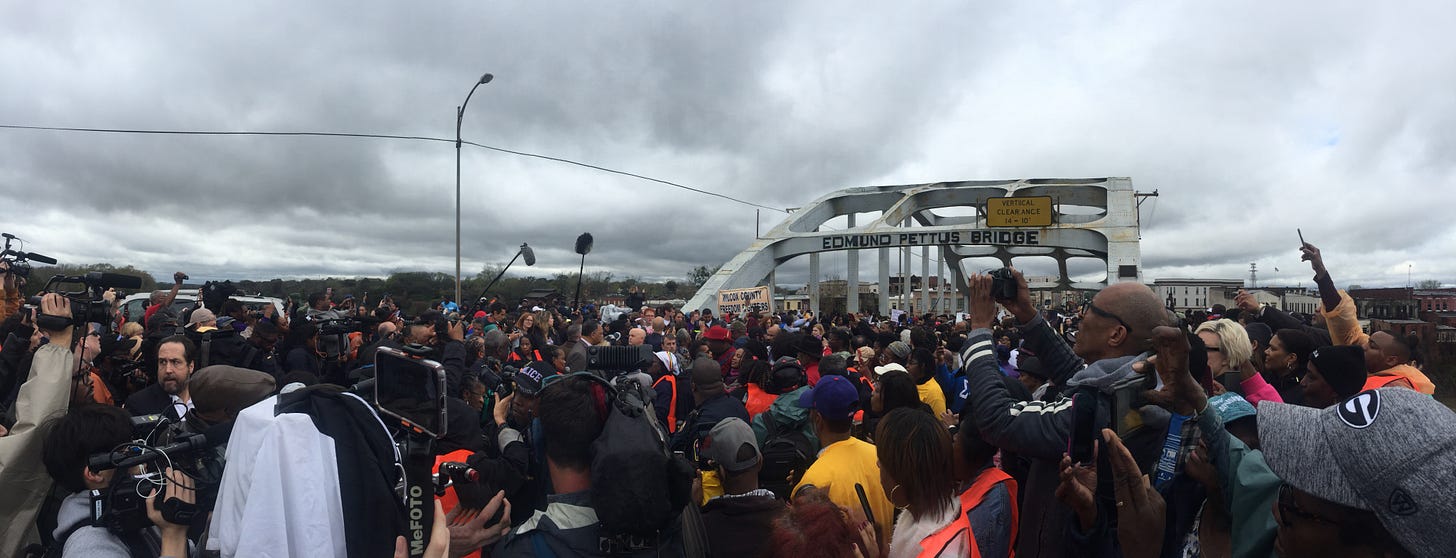
"Hey, Rashan! You wanna meet John Lewis?"
"What?"
"Congressman John Lewis. The Civil Rights hero...?"
"Yes, I know who he is. But what do you mean 'meet him'?"
"He'll be here in five minutes."
"Oh! Where exactly?"
"Back by the senator's office."
"Okay, let's go now."
I got up that second and walked to the anteroom just outside of my boss' door in the Dirksen Senate Office Building. In my nervous haste, I didn't pause to adjust my tie, or push my shirt sleeves down, or throw my jacket on to make myself presentable. I didn't grab my cell phone for a selfie. I just knew that I couldn't miss my chance to meet a living legend.
I quickly found that I had no reason to be nervous. John Lewis was maybe the nicest, most humble person I've ever met. And I say this without hyperbole.
"Hi, what's your name?" Congressman Lewis asked as he took my hand in both of his.
"Rashan Colbert, sir. It's a pleasure to meet you!"
"It's a pleasure to meet you, Rashan. My name is John Lewis. I represent Georgia's 5th Congressional District, down in Atlanta."
He took his time and spoke with all of my coworkers who came to see him. After shaking our hands, and seeing us all standing there staring at him, googly eyed, without the courage to speak, he took gentle control of the room and told us more about himself. We all knew, but we were honored to be listening.
"I come from a small, rural town in southern Alabama called Troy. I grew up there, the son of a sharecropper, and later went to school at Fisk University in Nashville. I did some civil rights organizing, working with Dr. Martin Luther King, and I formed an organization called the Student Nonviolent Coordinating Committee."
He paused, perhaps hoping that this bunch of supposedly bright young public servants before him would have something interesting to say, or an insightful question to ask. No such thing happened, and he calmly continued.
"We conducted sit-ins, and we marched, and protested for our civil rights. And sometimes we would be arrested and get into trouble. Good trouble..."
The door to the private office behind us flew open and my larger than life (in a decidedly more physical sense than the slight and demure Mr. Lewis) boss, Cory Booker, came into the room.
"Congressman Lewis!" he bellowed.
"Hey, Cory!" John Lewis said with a smile as he turned to greet the senator. Before walking away he pivoted briefly back to the group of us still standing there. "It was good to meet you. Keep working hard." And he and Senator Booker retreated into the office to talk.
I stood there in the anteroom with my colleagues for a moment longer. We looked at each other and smiled, half-wondering if that really just happened. We eventually filed slowly back to our desks and proceeded to gush about the experience for the rest of the day.
I had the good fortune to interact with Congressman Lewis a few more times over the years. But it was more than two years later, and almost a thousand miles away, when I felt most connected to him.
A BRIDGE IN ALABAMA
After a long and tiring twenty-four hours that included a flight - filled with twittering journalists - from Charleston to Birmingham, a midnight hotel change after a colleague saw a drug deal go down in her hallway, and a pre-sunrise road trip to the town of Selma, I found myself sheltered from the pelting rains of an approaching tornado within the confines of a small AME church called Brown Chapel.
The University of Alabama's Afro American Gospel Choir filled the unassuming holy room with a compelling and bewitching harmony that would make even the furthest astray of sheep feel a touch of the holy spirit. The organ sounded behind the choir, and the thunder outside added a percussion accompaniment that shook the rafters. Everyone's phone buzzed to alert us to potential flooding.
Speaker after speaker processed to the microphone and stood at the pulpit where Dr. Martin Luther King inspired a crowd to get into some good trouble exactly fifty-four years before. Sherrilyn Iffil - the leader of the strong right arm of the NAACP, the Legal Defense Fund - spoke about the continuing work she and her acolytes were doing across the country to protect the rights of Black and brown communities. Representative Terri Sewell, a daughter of Selma, and a member of Brown Chapel, enjoyed a reception fitting for a hometown crowd, and kept everyone engaged with her energy and powerful voice. Reverend Leodis Strong, the lead Pastor at Brown gave us the Word.
Secretary, Senator, First Lady, almost-President Hillary Clinton was the lone white face on the stage that morning. I had never seen an individual receive more deference from a large crowd than I did when she rose to speak. She kept her remarks short, sweet, and surprisingly funny before introducing my boss, Cory Booker, to give the keynote sermon for the day.
He preached about our gathering that morning.
"We gather here, as they did then - when the conditions are morally unacceptable. [...] Now, I want to remind you that this church gathered together in this sanctuary at a time when they were making it illegal for Black folk to gather together. And even though it was illegal, on the day of the march, folk gathered here, understanding that when two or three are gathered together in His name, He is in the midst. It was 600 who came together then. They knew that in unity is strength."
He continued with the sermon, quoting from the book of Genesis, and telling the story of Joseph: "Now Joseph’s brothers saw him in the distance, and before he arrived, they plotted to kill him. ‘Here cometh the dreamer!’ they said to one another. ‘Come now, let us slay him and throw him into one of the pits. We can say that a vicious animal has devoured him. Then we shall see what becomes of his dreams!’” [Genesis 37:18-20]
Senator Booker closed the sermon by relaying a story he was told by a white New Jersey lawyer who became a Civil Rights worker after seeing a rare moment of breaking news on March 7, 1965: "They broke away from an ongoing movie to show a bridge in Alabama. And he said he watched the news as these marchers left a sacred sanctuary and went to march across that bridge, and he said he watched them as they were confronted by Alabama State Troopers. Those marchers were gonna kneel and pray, but they didn't get the chance to kneel and pray. I know they were gonna kneel and pray because I've talked to some of the foot soldiers. I've talked to a man who's now my colleague...always my hero, John Lewis. He told me they would kneel and pray. But just as they went to pray: they get gassed. Teargas shot at them. They get stormed at with billy clubs beating them viciously. And this man on a couch in New Jersey is horrified by what he sees."
The service ended and we hid in the rooms and hallways beneath the church as the rain continued outside.
The tornado turned and an hour later the rain stopped. The congregation - regular members of the church and visitors from out of town, like me - made its way above ground to finish what we'd come to do. We had come to walk across the Edmund Pettus bridge like John Lewis did fifty-four years before us. The sun was fighting to break through the mass of light grey clouds that blanketed the sky. Jesse Jackson was there, accompanied by his granddaughter who had the biggest afro I've ever seen in real life. He was larger and older than I remembered. Gone were the days of soaring rhetoric and the energy that seared him into my imagination so vividly. But he was there with his sneakers on, ready to walk.
The politicians linked arms with the Marchers. A small number of the original heroes who crossed the bridge that day were there. They, like Jesse, didn't move as swiftly as they once had, but came prepared for the task ahead of them. Dozens of journalists stood before the crowd, jockeying for position to get the perfect shot. I fell in somewhere behind the vanguard, among the hundreds who'd come to commemorate the sacrifices made generations before.

[photo: New York Times]
The air was filled with music: the a cappella singing of the hymns they sung half a century ago to stay united and motivated in the face of terror. I added my voice to that sound.
Woke up this morning with my mind set on freedom
Woke up this morning with my mind set on freedom
Woke up this morning with my mind set on freedom
Hallelu, hallelu, hallelujah.
I’m walking and talking with my mind set on freedom
I’m walking and talking with my mind set on freedom
I’m walking and talking with my mind set on freedom
Hallelu, hallelu, hallelujah.
Walk, walk, walk, walk…
Talk, talk, talk, talk…
Ain’t no harm to keep your mind set on freedom
Oh, there ain’t no harm to keep your mind set on freedom
There ain’t no harm to keep your mind set on freedom
Hallelu, hallelu, hallelujah.
The walk from Brown Chapel to the bridge was short - just a half-mile through the residential and commercial blocks that made up the distance from there to the Alabama River. The brevity of the journey reminded me that this was just the very beginning of a march meant to carry on to the capital city of Montgomery, over fifty miles away. They were marching that day to protest the voting rights that Black people in Alabama, and all across the country, were being denied. They were marching to commemorate the unjust death of Jimmy Lee Jackson, who'd been beaten, shot, and killed the previous month by Alabama State Troopers. They were going to the capital city - 600 strong - to make their voices heard.
The world knew they were coming. The opposition knew they were coming. And in their fear of what that group represented, they came ready to do battle. With guns, and shields, and clubs, and horses.
John Lewis carried nothing but a backpack with clothes and food.
My first glimpse of the Edmund Pettus Bridge was surreal. It was so small and so close, and surrounded by a whirlpool of peaceful chaos. There were hundreds already at the bridge, waiting for the group that came over from Brown Chapel. Black Lives Matter flags waved through the air. Singing from different groups clashed in disharmony. Voices on bullhorns called out chants and issued instructions. A contingent of police and security made its presence known as they tried to direct the foot traffic, blowing shrill whistles, and gesticulating wildly. Secretary Clinton's Secret Service detail quietly boxed out any unapproved participants who ventured too close to their ward. A group in orange safety vests performed a two-minute "die-in" - laying still at the foot of the bridge to protest the Black bodies that had been stilled unjustly across the country. The press snapped away, filling the air with a constant whir of their high-powered shutters.
Reverend Barber, the modern day Civil Rights leader, was there. He moved, in his hunched and cane assisted, though dignified way, to the center of the maelstrom. He held hands with Senator Booker, and Secretary Clinton, and Jesse Jackson, and the original marchers from fifty-four years ago, and called for a moment of prayer. Within seconds, the hundreds went silent. There was no microphone to amplify his voice, so it wasn't the words that silenced the crowd, but the opportunity to pay respect to those who had suffered in that spot a half-century before.

The prayer ended and we marched across the bridge. There was no one there to stop us. People took pictures. We smiled and laughed and held hands and sang.
I cried.
At the age of twenty-five John Lewis stood at the very front of that group of 600 marchers fifty-four years before I stood there. They were met, at the other end of the Edmund Pettus Bridge, by horse-mounted Alabama State Troopers and television cameras.
"The troopers came toward us with billy clubs, tear gas, bull whips, trampling us with horses. I felt like it was the last demonstration. It was the last protest on my part. Like I was going to take my last breath from the tear gas. [...]
You come to that point - and I think it's very much in keeping with the philosophy and the discipline of nonviolence - that in spite of the fears, the misgivings, or the reservations you may have, you tend to lose that sense of fear and you keep your eyes on the prize. [...]
The days after Bloody Sunday there were demonstrations, non-violent protests, in more than eighty major cities in America. People didn't like what they saw happening there. There was a sense that we had to do something, and we had to do it now. We literally - in my estimation - wrote the Voting Rights Act with our blood, and with our feet."
- John Lewis
The first club came down on John's head. He was cracked open and suffered a fractured skull at the hands of the law. He and fifty-seven others were treated for serious injuries at the local hospital that day.
The Voting Rights Act of 1965 was signed into law five months later.
John Lewis got back on his feet and never stopped getting into trouble...good trouble...with his eyes firmly on the prize.
He went on to well deserved rest yesterday. May we keep our eyes on the prize and be deserving of the pain he suffered for us, and the freedoms he secured for us.
Rest in Power, John.
PS: Thanks Corey, for sending me that photo last night.

